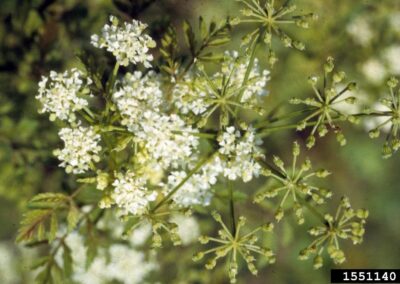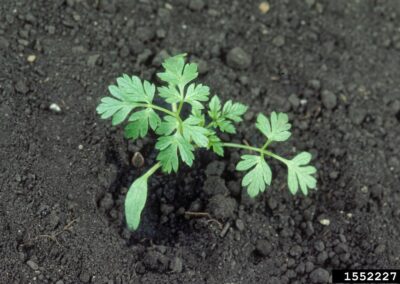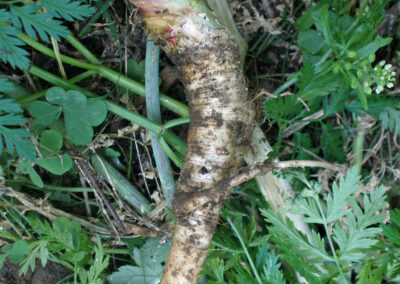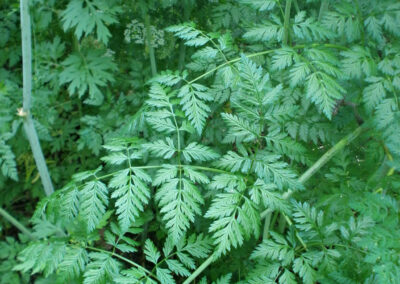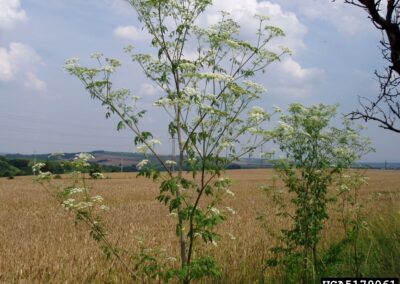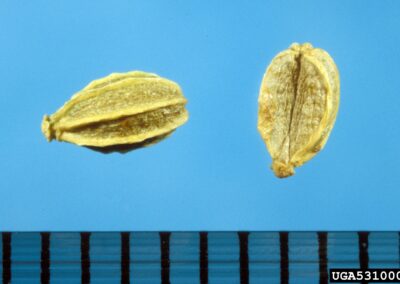
Poison Hemlock
Conium maculatum
Class B
Llimited to portions of the state. In areas with severe infestations, management should be designed to contain the infestation and stop any further spread.
Children & Pets
This plant may pose a particular risk to unsupervised children and animals due to its toxicity or potential for injury.
Toxic to Horses
This plant has been documented to sicken or injure horses.
Livestock Hazard
This plant presents a threat to the health and/or quality of livestock.
Warning! If you may have ingested or inhaled this plant, contact poison control immediately at 1-800-222-1222
QUICK FACTS
- Poison hemlock is one of the deadliest weeds in the U.S., often mistaken for wild carrots or parsley. Key identifiers include purple blotches on smooth, hollow stems and a foul odor when crushed. Ingesting even a small amount can be fatal.
- Introduced in the 1800s, this toxic plant spreads rapidly in moist, disturbed soils like roadsides and ditches, producing up to 40,000 seeds per plant. It displaces native species and threatens ecosystems, livestock, and public health.
- There is no cure for hemlock poisoning, which causes respiratory failure within hours. Protective gear is essential when handling it, and the most effective control method is manual removal with root and seed destruction.
1. Overview
An infamous legend in the world of plants. The trespasser that lurks in the shadows of wetlands, awaiting its next victim.
Poison hemlock is one of the most dangerous weeds in the United States, having taken countless lives from those who mistake it for an edible forage. Poison hemlock closely resembles wild carrots or cow parsley, leading many people to mistakenly consume it. The key distinguishing feature between the two is the presence of purple splotches on the stem of the hemlock, which serve as the only clear indication that it is not an edible member of the carrot family.
History of Poison Hemlock
Poison hemlock is a plant native to Europe, North Africa, and parts of Asia. Introduced to North America in the early 19th century, it was initially intended for use as an ornamental garden plant. However, its toxic nature became tragically evident in 1893 when an individual ingested the plant and subsequently succumbed to its lethal effects. The consumption of any amount of poison hemlock can be fatal, necessitating immediate medical intervention for survival. Following its introduction to the United States, this noxious weed proliferated, eventually spreading to Canada, Australia, New Zealand, and South America. [2,7]
The most famous historical use of poison hemlock was in 399 BCE, when it was used to execute the philosopher Socrates. He was sentenced to death by drinking a concoction made from the plant, as described by Plato in Phaedo. [8]
Despite its toxicity, poison hemlock was sometimes used in traditional medicine in tiny doses as a sedative or antispasmodic. However, its use is extremely risky due to the narrow margin between therapeutic and lethal doses. [9]
2. ID Guide
What does it look like?
When trying to identify this particular weed, it’s important to remember that it closely resembles wild carrot or cow parsley. However, there are key differences that can help you distinguish poison hemlock from these similar plants. One noticeable feature is the presence of purple streaks or splotches on the stems of poison hemlock, which other carrots lack. Additionally, while wild carrot leaves and cow parsley stems have fine hairs, the leaves and stems of poison hemlock are smooth and hairless. Another distinction is that the stems of poison hemlock are hollow, whereas the stems of similar plants are solid. Due to these similarities, many people unknowingly ingest poison hemlock, mistaking it for wild carrot, which can have fatal consequences. [4]
Having trouble identifying a weed? Contact your local conservation district or county extension agent.
Key Features
- Plant: The plant itself can grow 6ft-10ft tall, and the stems are usually ribbed, hollow, and have purple splotches/streaks. The stems are smooth and hairless, a distinguishing feature. When the plant is broken up, it releases a rank-smelling odor. Poison hemlock will appear shorter and more carrot-like in its first year of growth. [2,6]
- Roots: The long taproot resembles a white carrot, characterized by its thick base and typically white color. This root primarily grows in winter and can sometimes branch. [2,6]
- Leaves: Have a fern-like appearance and are finely pinnately divided. They closely resemble leaves from other members of the carrot family, with their dark green parsley-like leaves. [2,6]
- Flowers: Flowers are usually small and white or yellowish. They have a broad base but narrow tips. They grow in a half-dome of small umbrella-like clusters at the ends of branched stems. Each tiny flower has five petals. [2,6]
- Seeds: Green, round, and deeply ridged fruits develop from each tiny flower. These will dull into a grey-brown color as the plant dies. Each fruit contains several small seeds, which are flat with ridges. [1,5]
John Cardina, The Ohio State University, Bugwood.org
Flowers grow in a half-dome of small umbrella-like clusters at the ends of branched stems.
Ohio State Weed Lab , The Ohio State University, Bugwood.org
Poison hemlock will appear shorter and more carrot-like in its first year of growth.
Jan Samanek, Phytosanitary Administration, Bugwood.org
The plant itself can grow 6ft-10ft tall, and the stems are usually ribbed, hollow, and have purple splotches/streaks.
3. Infestation Basics
“On Monday, two of (Duncan) Gow’s children gathered what they took to be parsley and brought a quantity of it home with them. Their father ate it greedily with a piece of bread… he died three hours and a quarter after eating the hemlock.”
– J. Hughes Bennet, M.D., 1845
Where and how does it grow, and how does it spread?
Poison hemlock has a broad ecological tolerance and can be found in a variety of habitats, ranging from disturbed to undisturbed soils. Its growth is not highly selective concerning moisture levels; however, it exhibits particularly vigorous growth in environments that provide ample moisture.
Poison hemlock tends to thrive in a variety of environments, often appearing in areas such as roadsides, cultivated fields, creek beds, irrigation ditches, riparian forests, and disturbed sites. This weed primarily propagates through its seeds, which can be disseminated by several vectors, including mud on vehicles, water, clothing, animal fur, and machinery. Because the seeds are so small, seed transport often occurs without detection, contributing to their widespread distribution. [2,4]
Key takeaway: The most effective way to prevent the spread of poison hemlock is hand-pulling, which requires wearing gloves, safety glasses, and a dust mask for safety.
Why is it so invasive?
The invasive nature of poison hemlock can be attributed to three main factors: its capacity to outcompete native vegetation, its lethal toxicity, and its rapid propagation in disturbed areas.
Primarily, poison hemlock undermines local ecosystems by aggressively competing for vital resources, thereby jeopardizing the survival of surrounding plant species. Moreover, its high toxicity poses a significant threat to both human and livestock health, as ingestion of even a small amount can be fatal. The plant’s ability to spread rapidly in disturbed environments further exacerbates its invasive status. [2]
Poison hemlock is a rapidly spreading plant, especially after rainy seasons, that thrives in disturbed areas and outcompetes native plants by depriving them of adequate sunlight. It negatively impacts agriculture by interfering with crops and livestock feed. The plant is known for its toxicity, causing respiratory paralysis in vertebrates after ingestion due to its alkaloids, which depress the central nervous system. Symptoms include nausea, convulsions, and muscle weakness, leading to death within a few hours in livestock. [2]
Wildlife is vulnerable to the harmful effects of poison hemlock. In 1985, ten percent of the elk population on Grizzly Island, California, perished after ingesting this toxic plant. [2]
The plant will emerge in early spring, where it typically will persist over two years. Under ideal conditions, the weed may exist as a perennial. The reproductive parts of poison hemlock develop in mid-April, typically one year after germination. During summer, once the plants set up to 40,000 seeds, they die back, leaving tall stalks that can overshadow other plants. The seeds reach full maturity by mid-June, with about 90% of them being dispersed from September to December and the rest by late February. This extended dispersal period allows for continuous seedling production over several months, ensuring that some seeds remain viable in the soil for up to three years. Germination is most successful in soil but can also occur in sand, allowing seedlings to emerge nearly year-round, except during April, May, and July. [1,2,6]
Given its lethal properties and potential to proliferate swiftly, poison hemlock has rightfully earned its reputation as a highly detrimental invasive weed. It is imperative that we address this issue promptly, as its presence has already resulted in numerous fatalities. [2,3,6]
Key takeaway: Exercise extreme caution when handling this plant, as it contains toxic compounds that are fatal to both humans and livestock if ingested. There is no known cure for hemlock poisoning, and this should be taken into consideration before implementing any proximity management methods.
Common risk factors for invasion
- Disturbed Soils: Poison hemlock is particularly fond of invading areas where the soil has been disturbed, such as construction sites near wetlands, hiking trails, or roadside ditches. This disruption weakens existing vegetation, allowing the weed to become established and thrive. Minimizing unnecessary soil disturbance can help reduce the risk of invasion. [1,2]
- Moisture availability: While poison hemlock has adapted to a wide range of soil and water conditions, it does generally require adequate moisture to establish and spread, making irrigated lands and areas with consistent rainfall particularly vulnerable. [1,2]
Impacts
Ecosystem Health
Once established, poison hemlock effectively displaces native vegetation, leading to a significant reduction in floral and faunal biodiversity. This decline can further diminish forage availability for game species, particularly during winter months, and may even alter migratory patterns. Due to its high toxicity, poison hemlock is unfit for consumption by any wildlife. The displacement of native plants ultimately leaves wildlife with insufficient food resources, prompting them to relocate in search of foraging options. Additionally, the visual similarity between poison hemlock and wild parsnip heightens the risk of accidental ingestion by wildlife. [1,2,5]
Health and Safety
Poison Hemlock is highly toxic; less than 0.5% of an individual’s body weight can be lethal within 2 to 3 hours. The plant causes respiratory paralysis, which can ultimately be fatal without immediate medical intervention. Tragically, there have been numerous incidents of poisoning among children, often arising from their use of the hollow stems as makeshift flutes. [2,4,5,10]
Livestock
Sheep, goats, cattle, and horses are known to graze on various types of weeds, often utilizing specific species as a food source. However, poison hemlock is an exception, as it is highly toxic and unpalatable to all living creatures. When livestock consume poison hemlock, it can lead to respiratory paralysis, ultimately resulting in cessation of breathing and, consequently, death. [1,2,3]
In pregnant livestock, ingestion of this toxic plant not only poses a lethal risk but may also endanger the developing fetus, leading to severe congenital deformities such as skeletal malformations or cleft palate. These deformities can severely compromise the health and viability of the offspring. Furthermore, the toxicity of poison hemlock extends beyond direct consumption; milk from cows that have ingested this plant can pose health risks to humans, emphasizing the importance of preventing livestock access to this dangerous plant. [1,2,5]
4. Management Strategies
When managing this specific weed, it is essential to wear appropriate personal protective equipment, including safety glasses, gloves, and a face covering, particularly when handling or cutting the plant. The most effective method for controlling this weed is to remove it entirely from the ground, ensuring that the entire root system and all seeds are eradicated. Currently, there are no known biological control methods available for Poison Hemlock due to its extreme toxicity. Alternatively, the use of herbicides can be considered for the complete elimination of the plant. Caution is advised when applying herbicides, as improper use can have detrimental effects on the soil ecosystem. [3,6]
DO’s
- Always wear gloves, long sleeves, long pants, and eye protection. Toxins can be absorbed through the skin or mucous membranes.
- Control poison hemlock in early spring before it flowers and sets seed to prevent spreading.
- Recheck treated areas regularly, as seeds can remain viable for several years in the soil.
DON’Ts
- Mow or weed-whack live plants, as cutting live poison hemlock can aerosolize toxins, posing a serious inhalation hazard.
- Allow livestock or pets near it, even small amounts ingested by animals can be fatal. Fence off known patches if animals are nearby.
- Avoid burning the plant, as burning can release toxic fumes.
** The following information is provided courtesy of the UC Weed Research and Information Center. nmweeds.org does not endorse the use of any particular product, brand, or application thereof. **
Use extreme caution when working with poison hemlock. Always wear gloves and protective clothing, and ensure safe disposal of the plant material in a sealed bag.
| Hand-pulling | Hand removal is recommended for small infestations. When pulling the plants, dig down and remove the entire taproot. Wear gloves and wash your hands after working with poison hemlock. Manual control efforts can be successful, but can cause soil disturbance, encouraging further germination of seeds. Solid carpets of hemlock seedlings are not uncommon following soil disturbance. |
| Mowing | Cutting is ineffective; the plants send up new seed stalks in the same season the cutting occurs. Establishment of populations can be prevented with repeated cultivation and plowing. |
Due to the plant’s toxicity, grazing is not recommended for control. Even dried plant parts are not safe, as the toxins take several years to dissipate. Use certified weed-free hay to prevent the poisoning of livestock. Do not burn, as toxins can be released into the air through the smoke.
There are no known biological controls. Since its introduction to North America, only a few native insects have been able to overcome its toxic defenses. These attack the seedhead, but do very little damage to the rest of the plant.
The following specific use information is based on published papers and reports by researchers and land managers. Other trade names may be available, and other compounds also are labeled for this weed. Directions for use may vary between brands; see label before use. Herbicides are listed by mode of action and then alphabetically. The order of herbicide listing is not reflective of the order of efficacy or preference.
|
2,4-D Several names |
Rate: 1 to 4 pt product/acre (0.48 to 1.9 lb a.e./acre) Timing: Postemergence in the seedling to rosette stage. Remarks: Broadleaf-selective, most effective when applied soon after plants emerge. Adding a wetting agent may enhance control. Also effective when tank mixed with dicamba. |
|
Aminocyclopyrachlor + chlorsulfuron Perspective |
Rate: 4.75 to 8 oz product/acre Timing: Postemergence in the seedling to rosette stage. Remarks: Broad-spectrum control of many broadleaf species. Although generally safe to grasses, it may suppress or injure certain annual and perennial grass species. Do not treat in the root zone of desirable trees and shrubs. Do not apply more than 11 oz product/acre per year. At this high rate, cool-season grasses will be damaged, including bluebunch wheatgrass. Not yet labeled for grazing lands. Add an adjuvant to the spray solution. This product is not approved for use in California and some counties of Colorado (San Luis Valley). |
|
Aminopyralid + metsulfuron Opensight |
Rate:2.5 to 3.3 oz product/acre Timing: Preemergence in fall, or postemergence in the seedling to rosette stage. Remarks: Not registered for use in California. |
|
Triclopyr Garlon 4 Ultra, Remedy |
Rate: 5 to 8 pt product/acre (2.5 to 4 lb a.e./acre) Timing: Postemergence in the seedling to rosette stage. Remarks: Broadleaf-selective, safe on most grasses. Most effective on smaller plants. Garlon 4 Ultra and Remedy Ultra are low volatile esters. However, in warm temperatures, spraying onto hard surfaces such as rocks or pavement can increase the risk of volatilization and off-target damage. Also effective in a premix with 2,4-D (Crossbow) or tank mixed with clopyralid (Transline). |
|
Glyphosate Roundup, Accord XRT II, and others |
Rate: Broadcast treatment: 1.33 to 2.67 qt product (Roundup ProMax)/acre (1.5 to 3 lb a.e./acre). Timing: Best when applied postemergence to rapidly growing plants before bolting. However, higher rates can control plants from the bud to the full bloom stage. Remarks: Glyphosate is a nonselective herbicide that has no soil activity. Add a non-ionic |
|
Chlorsulfuron Telar |
Rate: 1 to 2.6 oz product/acre (0.75 to 1.95 oz a.i./acre) Timing: Postemergence to rapidly growing plants. Remarks: Desirable grasses should be well-established before application. |
|
Imazapic Plateau |
Rate: 8 to 12 oz product/acre (2 to 3 oz a.e./acre) Timing: Preemergence. Remarks: Mixed selectivity, favors members of the Asteraceae and some grasses. Some soil residual activity. In postemergence applications, use methylated seed oil at 1.5 to 2 pt/acre. Not registered for use in California. |
|
Imazapyr Arsenal AC, Habitat, |
Rate: 2 pt product (Arsenal AC)/acre (1 lb a.e./acre); 4 pt product (Habitat)/acre (1 lb a.e./acre) + 1 qt/acre methylated seed oil Timing: Preemergence or early postemergence in the rosette stage. Remarks: Nonselective. Long soil residual, leaves more bare ground than other treatments, even a year after application. Do not apply more than 3 qt product/acre. Habitat is an aquatic registered formulation for use close to water. |
|
Metsulfuron Escort |
Rate: 1 oz product/acre (0.6 oz a.i./acre) Timing: Postemergence to rapidly growing plants. Remarks: Use a non-ionic surfactant or silicone surfactant. Prevent drift to sensitive plants. Apply only to pastures, rangeland, and non-crop sites. Metsulfuron can also be used in a premix with dicamba + 2,4-D (Cimarron Max). Metsulfuron and its formulations are not registered in California. |
5. Citations
[1] USDA. (2018). Poison Hemlock (Conium maculatum): USDA ARS. Usda.gov. https://www.ars.usda.gov/pacific-west-area/logan-ut/poisonous-plant-research/docs/poison-hemlock-conium-maculatum/
[2] CAL-IPC. (2017, October 16). Poison Hemlock (Conium maculatum). California Invasive Plant Council. https://www.cal-ipc.org/resources/library/publications/ipcw/report32/
[3] CSU. (2024). Guide to Poisonous Plants – College of Veterinary Medicine and Biomedical Sciences – Colorado State University. Colostate.edu. https://poisonousplants.cvmbs.colostate.edu/plant/100
[4] Anderson, E., Branstrom, I., & Hill, E. (2023, April 20). Poison hemlock identification and control. Www.canr.msu.edu. https://www.canr.msu.edu/news/poison-hemlock-identification-and-control
[5] Minnesota Department of Agriculture. (n.d.). Poison Hemlock. Www.mda.state.mn.us. Retrieved August 5, 2025, from https://www.mda.state.mn.us/plants/pestmanagement/weedcontrol/targetplants/elimtargetplants/poisonhemlock
[6] King County W.A. (2024). Poison hemlock identification and control. Kingcounty.gov. https://kingcounty.gov/en/dept/dnrp/nature-recreation/environment-ecology-conservation/noxious-weeds/identification-control/poison-hemlock
[7] Cleveland Clinic. (2022, September 8). Hemlock Poisoning: Symptoms, Treatment & Prevention. Cleveland Clinic. https://my.clevelandclinic.org/health/diseases/24122-poison-hemlock
[8] Plato. (1996). Phaedo. Cambridge University Press. (Original work published 4th century B.C.E.)
[9] Levy, J. (2011). Poison. Lyons Press.
[10] Sheley, R. L., & Petroff, J. K. (1999). Biology and Management of Noxious Rangeland Weeds. Oregon State University Press.
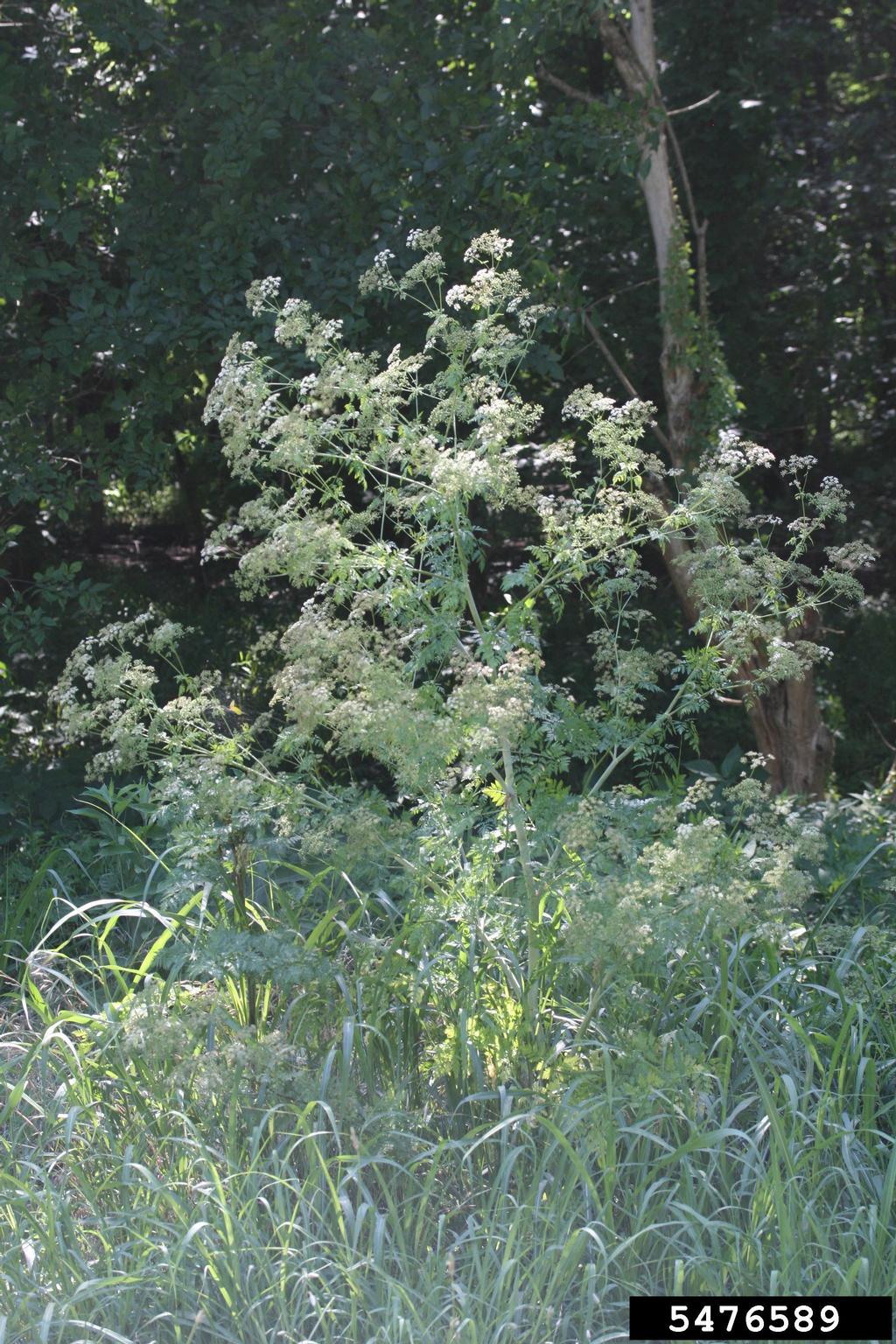
Chris Evans, University of Illinois, Bugwood.org
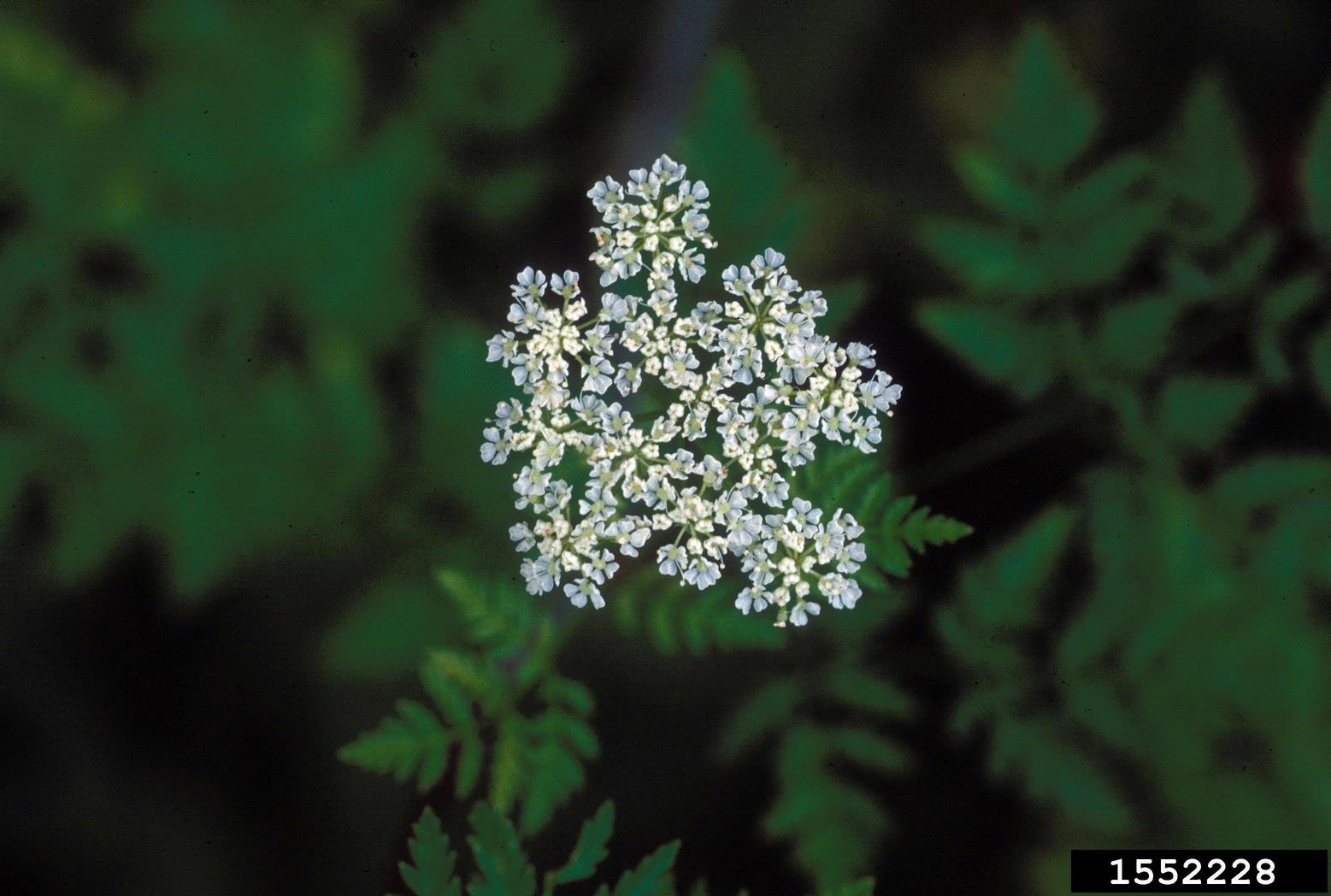
John Cardina, The Ohio State University, Bugwood.org
Symptoms of Hemlock Poisoning
- Sweating
- Vomiting
- Dilated pupils
- Excess salivation
- Dry mouth
- Rapid heartbeat
- High blood pressure
- Restlessness or confusion
- Muscle weakness and muscle twitches
- Tremors and seizures
Late Stage:
- Slow heartbeat
- Low blood pressure
- Muscle paralysis
- Muscle breakdown and muscle death
- Kidney failure
- Central nervous system depression
[7]
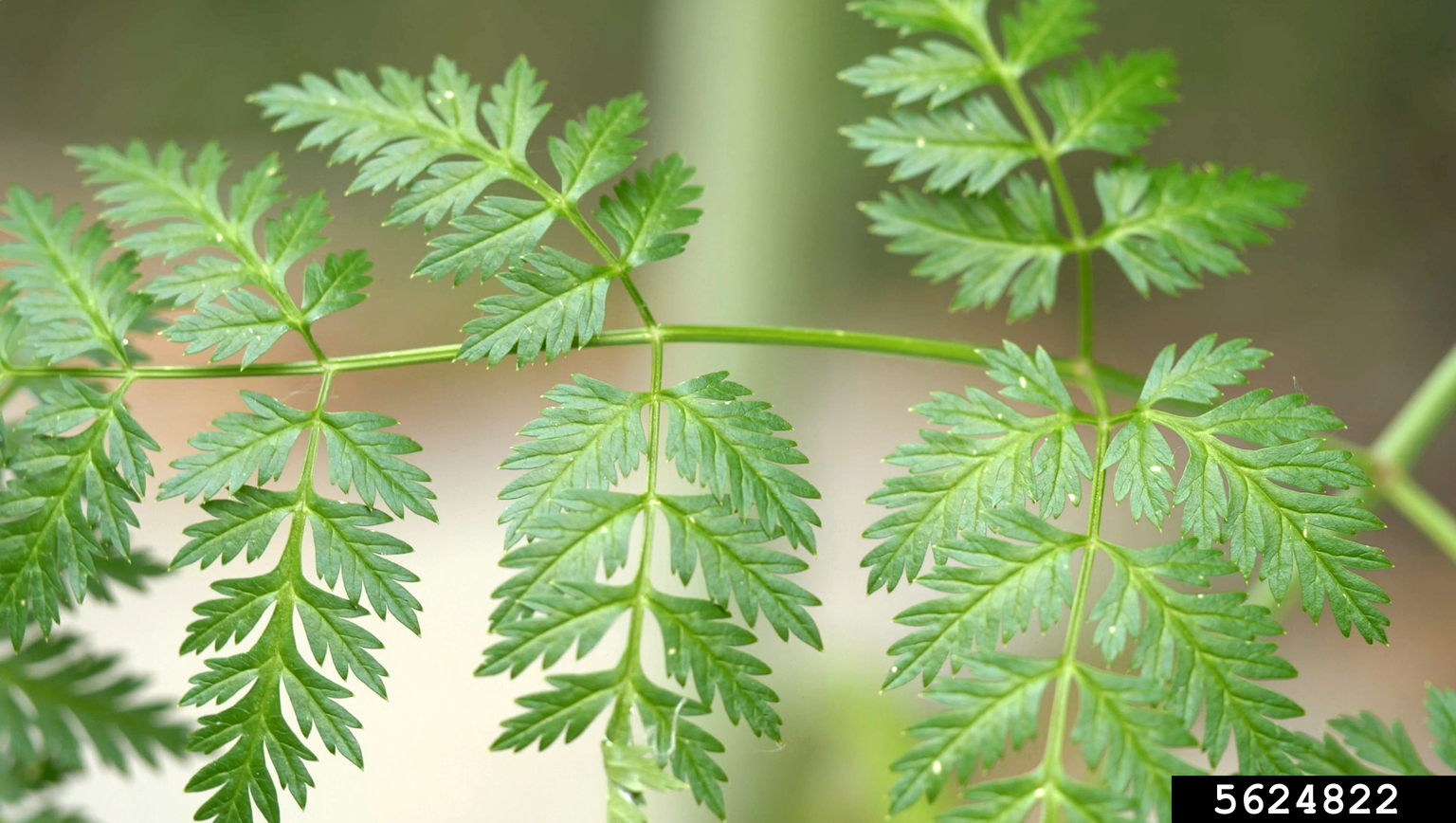
Travis McMahon, MIA Consulting, Bugwood.org
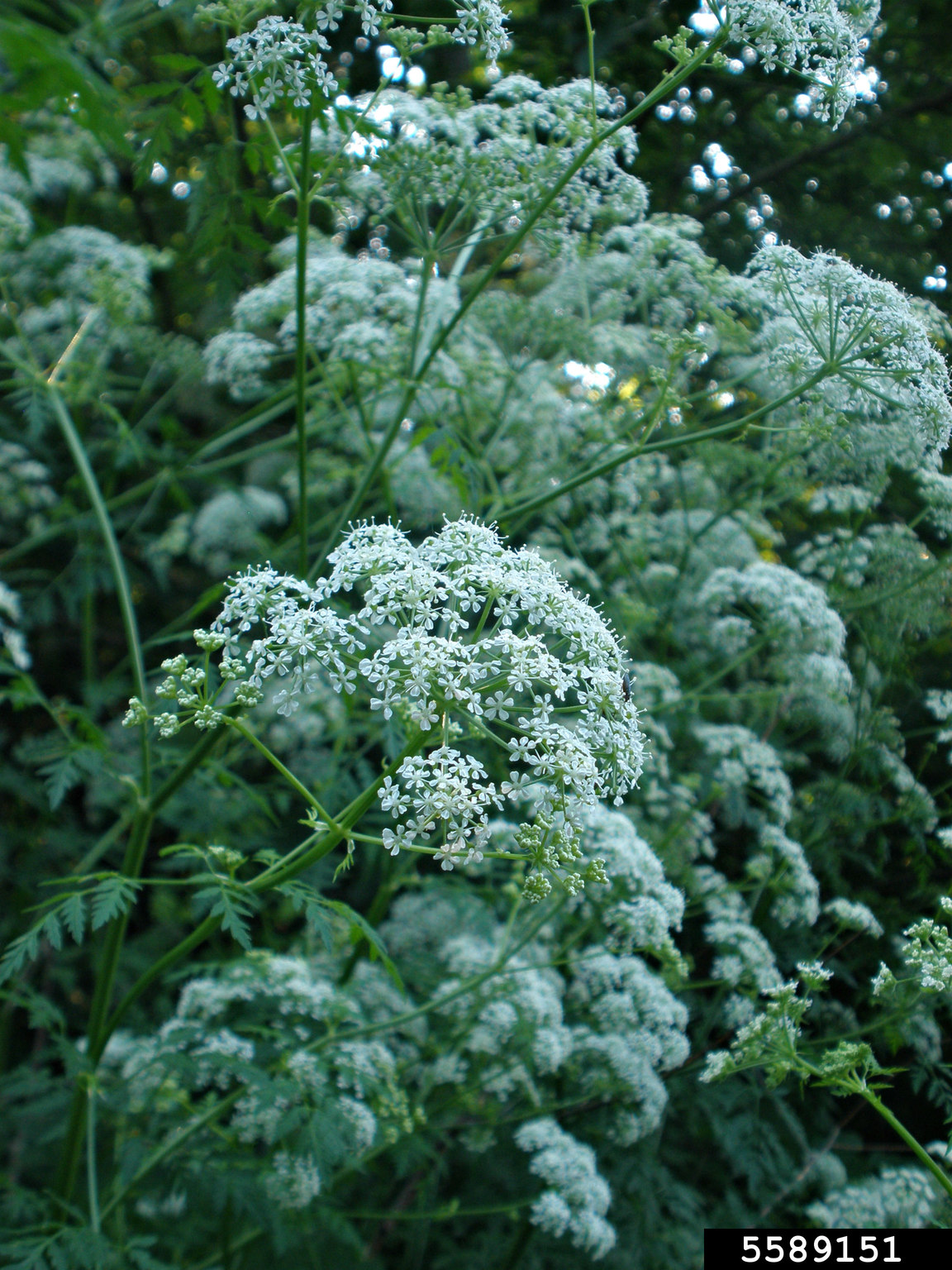
Ansel Oommen, Bugwood.org
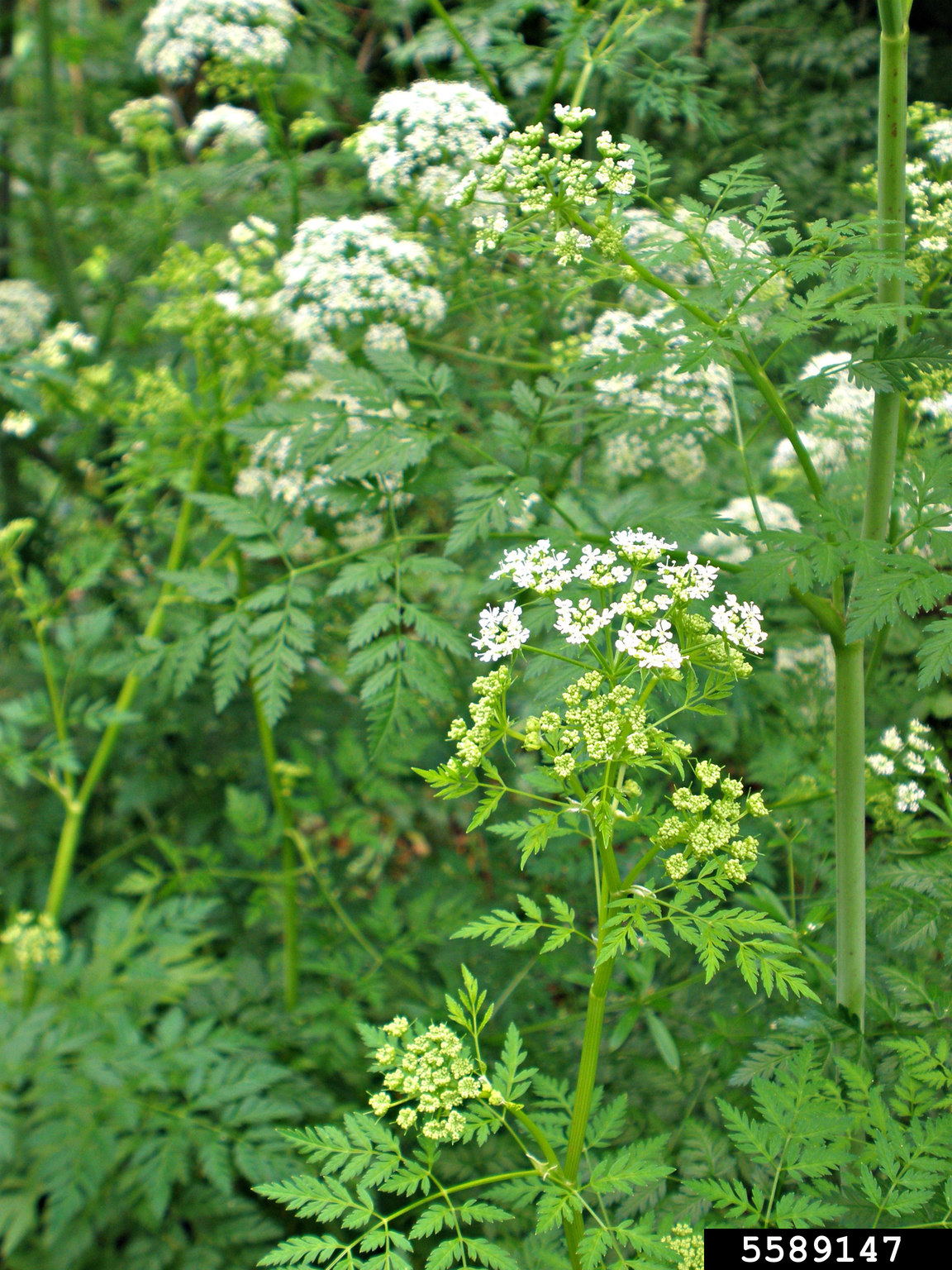
Ansel Oommen, Bugwood.org
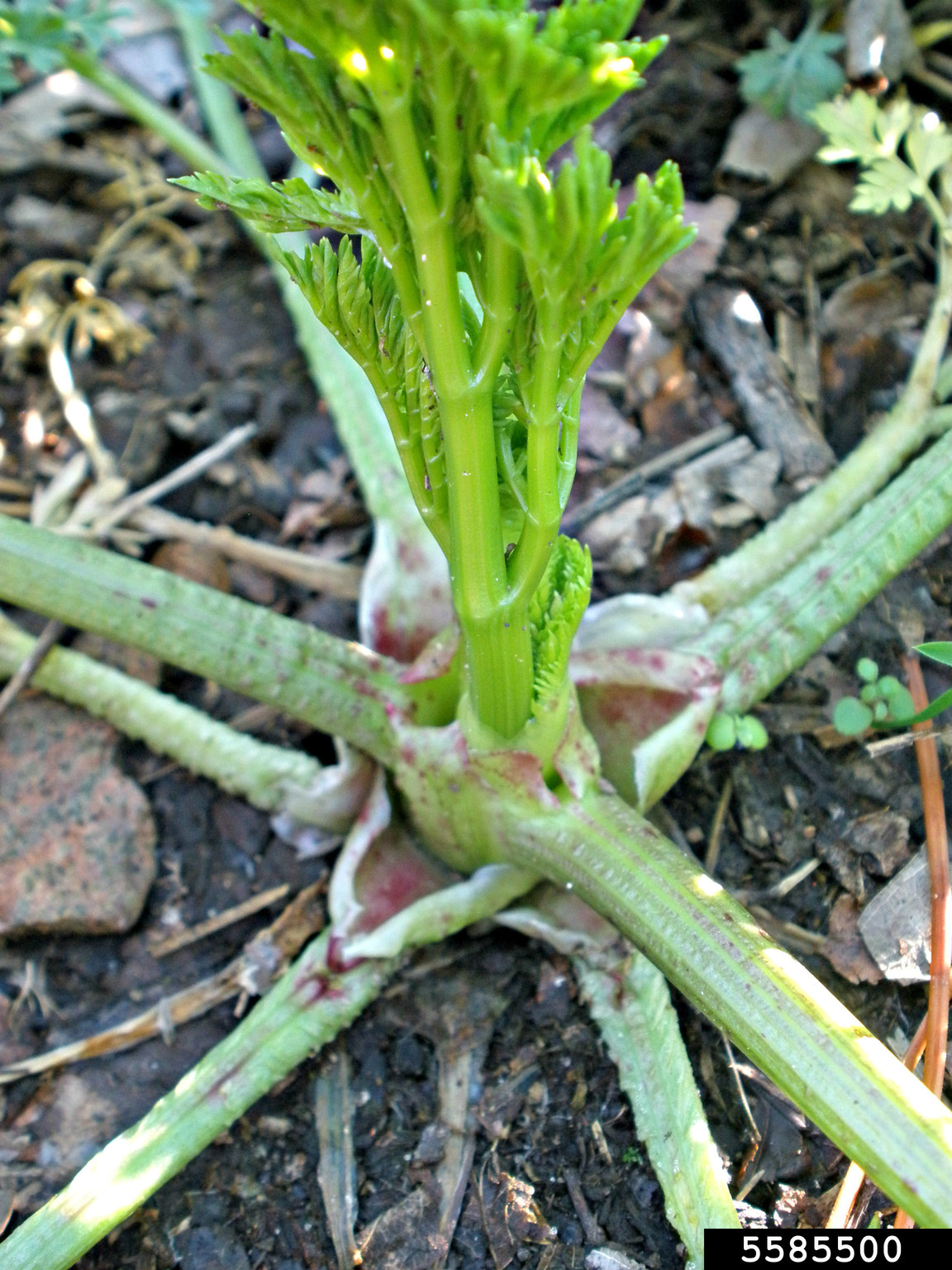
Ansel Oommen, Bugwood.org
Fun Facts
Conium in the ancient Greek language means “to spin or whirl” (like vertigo), and maculatum in the ancient Greek language means “spotted” or “blotched,” which describes the characteristics on poison hemlock’s stems.
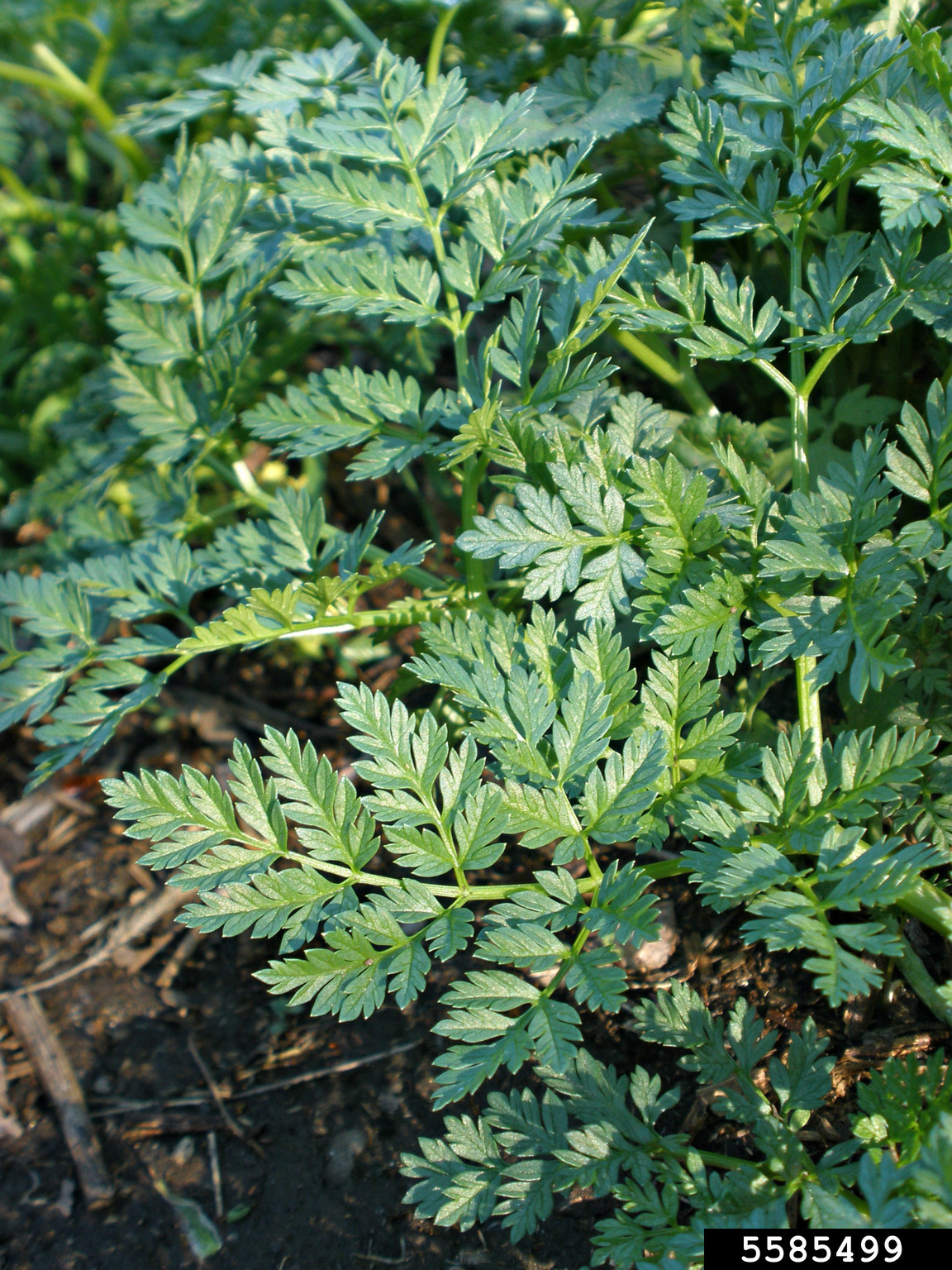
Ansel Oommen, Bugwood.org
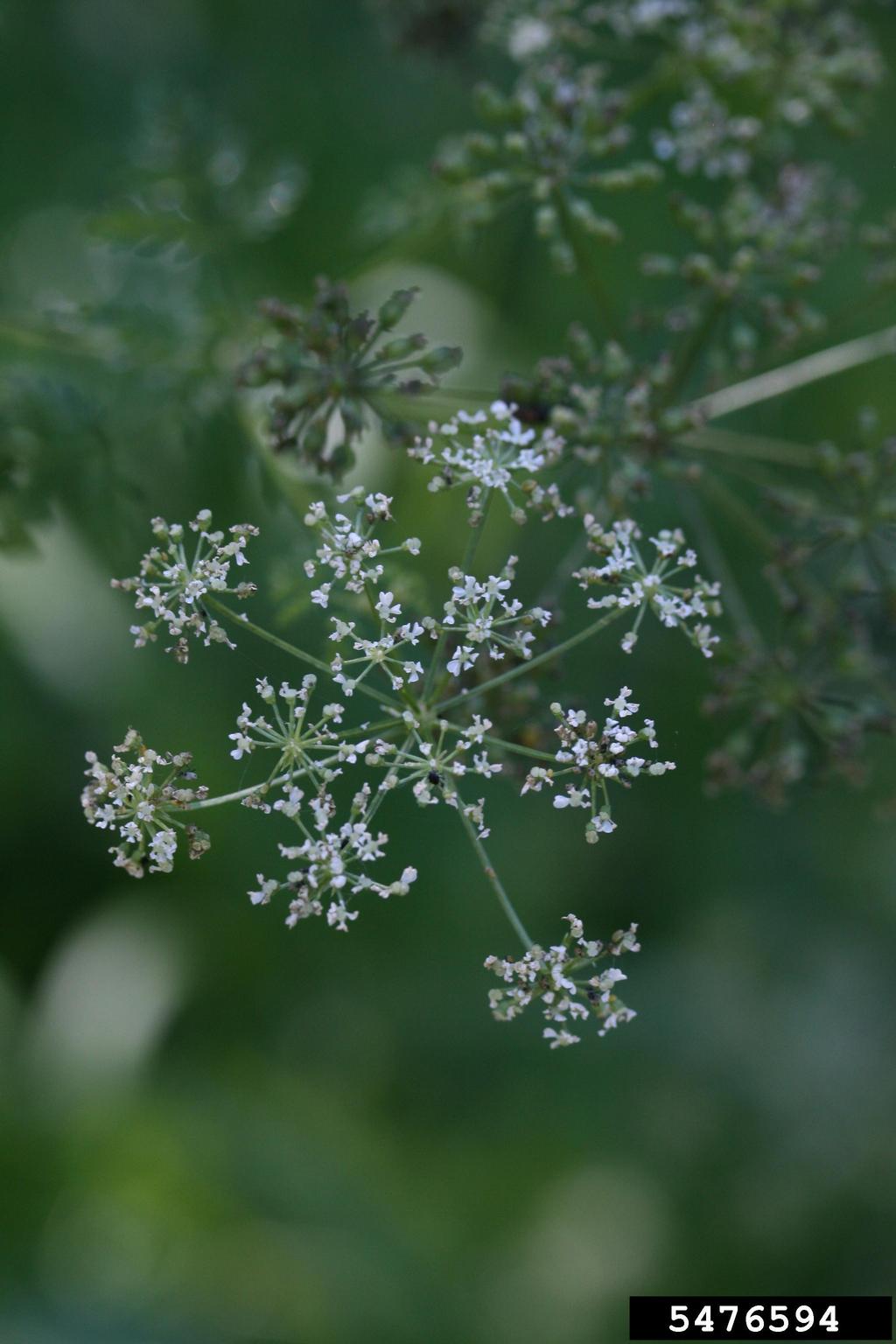
Chris Evans, University of Illinois, Bugwood.org
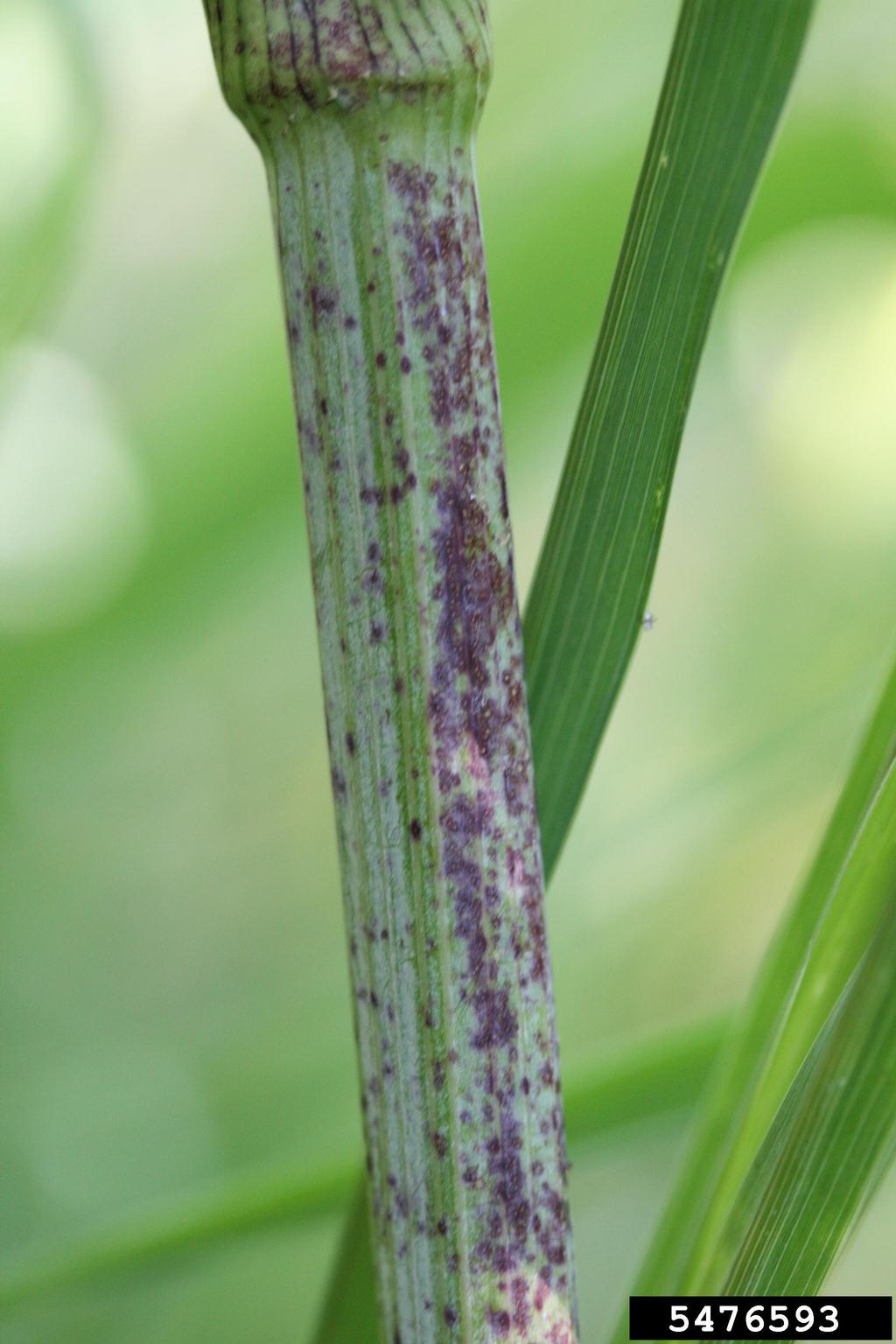
Chris Evans, University of Illinois, Bugwood.org

Chris Evans, University of Illinois, Bugwood.org

